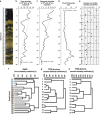Unexpected and novel putative viruses in the sediments of a deep-dark permanently anoxic freshwater habitat
- PMID: 22648129
- PMCID: PMC3475377
- DOI: 10.1038/ismej.2012.49
Unexpected and novel putative viruses in the sediments of a deep-dark permanently anoxic freshwater habitat
Abstract
Morphological diversity, abundance and community structure of viruses were examined in the deep and anoxic sediments of the volcanic Lake Pavin (France). The sediment core, encompassing 130 years of sedimentation, was subsampled every centimeter. High viral abundances were recorded and correlated to prokaryotic densities. Abundances of viruses and prokaryotes decreased with the depth, contrasting the pattern of virus-to-prokaryote ratio. According to fingerprint analyses, the community structure of viruses, bacteria and archaea gradually changed, and communities of the surface (0-10 cm) could be discriminated from those of the intermediate (11-27 cm) and deep (28-40 cm) sediment layers. Viral morphotypes similar to virions of ubiquitous dsDNA viruses of bacteria were observed. Exceptional morphotypes, previously never reported in freshwater systems, were also detected. Some of these resembled dsDNA viruses of hyperthermophilic and hyperhalophilic archaea. Moreover, unusual types of spherical and cubic virus-like particles (VLPs) were observed. Infected prokaryotic cells were detected in the whole sediment core, and their vertical distribution correlated with both viral and prokaryotic abundances. Pleomorphic ellipsoid VLPs were visible in filamentous cells tentatively identified as representatives of the archaeal genus Methanosaeta, a major group of methane producers on earth.
Figures



References
-
- Aeschbach-Hertig W, Hofer M, Schmid M, Kipfer R, Imboden DM. The physical structure and dynamics of a deep, meromictic crater lake (Lac Pavin, France) Hydrobiologia. 2002;487:111–136.
-
- Avnimelech Y, Ritvo G, Meijer LE, Kochba M. Water content, organic carbon and dry bulk density in flooded sediments. Aquacult Eng. 2001;25:25–33.
-
- Bastviken D, Cole J, Pace M, Tranvik L.2004Methane emissions from lakes: dependence of lake characteristics, two regional assessments, and a global estimate Global Biogeochem Cycles 18GB4009doi:10.1029/2004GB002238 - DOI
-
- Bath C, Cukalac T, Porter K, Dyall-Smith ML. His1 and His2 are distantly related, spindle-shaped haloviruses belonging to the novel virus group, Salterprovirus. Virology. 2006;350:228–239. - PubMed
-
- Batisson I, Pesce S, Besse-Hoggan P, Sancelme M, Bohatier J. Isolation and characterization of diuron-degrading bacteria from lotic surface water. Microb Ecol. 2007;54:761–770. - PubMed

